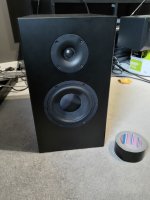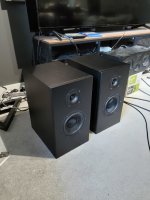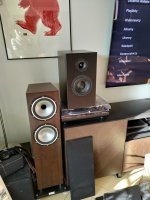The actual driver was 40-50cm from wall in open baffle maybe even more. The speakers are in the same spot in enclosure tho but enclosure adds lenghts. Literally this configuration sounded better by quite a big margine from what I have now. In both cases I use same crossover+dsp+sub. Theoretically they sound alright now and I asked even few people to listen to it but they could be beaten by market 1000usd speakers but they in open baffle that was temporarily made to test them was way way better sounding than any of my previous speakers.
Hard to understand last sentence. Use Dot or Comma or shorter sentences.
Thats very lousy setup, even for me, foamcore guy. Uneven fr response due to cancelation.
Update, I made new crossover with additional filters, smoothed frequency response, did big almost 30l enclosure and now it works fine althrough I expected bass to feel like floorstanding speakers considering the size of the enclosure but its still better than any bookshelf I heard but its also bigger than any bookshelf I've seen. f3 is in theory 34hz but It doesnt feel the same as from bigger floorstanding one. Its probably flat response what makes the bass not that impressive but either way Im finally happy with it. If anyone wants I can share photos and graphs of new design which works fine in ported enclosure
check post 16 & 26 from-
https://techtalk.parts-express.com/...ss-of-this-speaker-at-a-reasonable-cost/page2
post 26,"the new version is pretty much the same."
NOTE: these have the older woofer es180ti vs es180tia (differences?)
https://techtalk.parts-express.com/.../1296577-premios-a-small-high-end-stand-mount
https://projectgallery.parts-express.com/?s=es180t
https://techtalk.parts-express.com/...ss-of-this-speaker-at-a-reasonable-cost/page2
post 26,"the new version is pretty much the same."
NOTE: these have the older woofer es180ti vs es180tia (differences?)
https://techtalk.parts-express.com/.../1296577-premios-a-small-high-end-stand-mount
https://projectgallery.parts-express.com/?s=es180t
As expected: the driver is very particular about the enclosure - wanting something much closer to its own suspension (ie. "free air") rather than what a modified result is with the more typical "air-spring" result.-almost 30l ..ported enclosure..
Perhaps it's even particular about reflections as well? Is the enclosure considerably deeper than wide?
Again, a very low Rms driver can provide an excellent result as far as depth (and overall "space") is concerned, but often requires a fair bit more from the enclosure design and implementation to achieve that - and can otherwise result in something inferior-sounding.
Enclosure is 45x35x25 20mm mdf. F3 is around 35hz. Redesigned crossover with new filter and simplified construction (I left resistors in this way because they were already mounted on board). This isn't optimal way to do it but I was working with components I already had in first place.
They are quite pleasant to listen to but I already got to their limit twice and I hit their maximum volume usually and then woofer starts resonating and distorting in the highs around -6db before xmax clipping volume around 68% on denon avr 6300x and at 75% I hit their excursion limit in music. They are quite inefficient so my usual listening volume is around 62. Still bit annoying with that woofer highs resonating I think it could have been avoided if I would cross it lower. Either way I very rarely listen on such high volumes and I run them with ultimax 18 sealed and cross them at 40hz.
I run tweeter with one more 2R resistor. Tried it with 0-2-4R and 2 sounded best. Its not on a graph.


They are quite pleasant to listen to but I already got to their limit twice and I hit their maximum volume usually and then woofer starts resonating and distorting in the highs around -6db before xmax clipping volume around 68% on denon avr 6300x and at 75% I hit their excursion limit in music. They are quite inefficient so my usual listening volume is around 62. Still bit annoying with that woofer highs resonating I think it could have been avoided if I would cross it lower. Either way I very rarely listen on such high volumes and I run them with ultimax 18 sealed and cross them at 40hz.
I run tweeter with one more 2R resistor. Tried it with 0-2-4R and 2 sounded best. Its not on a graph.
Attachments
Last edited:
Cross them higher to the ultimax..40Hz is asking a lot of any small woofer with only 5.3mm xmax even if in a ported enclosure. Your AVR rolloff is likely also only 12dB so you are still asking the woofer to play below 40Hz
Secondly your graphs show a nominal 87dB sensitivity yet the woofer is only 84dB? Allowing for baffle step losses you should be targeting around 80 to 81dB. Where did you get your frequency response data from?
Edit. Your photos show a single woofer as does your crossover so I assume you have a TM and not MTM design?
Secondly your graphs show a nominal 87dB sensitivity yet the woofer is only 84dB? Allowing for baffle step losses you should be targeting around 80 to 81dB. Where did you get your frequency response data from?
Edit. Your photos show a single woofer as does your crossover so I assume you have a TM and not MTM design?
Data is directly from dayton, sensitivity on dayton graph is clearly 85db. I think 1 more db some kind of mistake but it applies to tweeter to, it also explaines why in room measurments show straight graph with 2ohm resistor added to tweeter.
Cross them higher to the ultimax..40Hz is asking a lot of any small woofer..

80 Hz
You need to as charlie suggested use gated measurement for the tweeter and quasi anechoic measurement for the woofer. I'm ok if your measurement data is not calibrated... I.e you simply recorded at an arbitrary volume and not 2.83v at 1m.Data is directly from dayton, sensitivity on dayton graph is clearly 85db. I think 1 more db some kind of mistake but it applies to tweeter to, it also explaines why in room measurments show straight graph with 2ohm resistor added to tweeter.
Did you change volume levels or mic position between woofer and tweeter measurement for the far field responses?
How have you determined Z axis voice coil offset between woofer and tweeter?
Did you smooth your measurements?
Can we see the full raw 20hz to 20khz measurements you are using for each driver? Or upload these as .txt. files here
There you go.Data is directly from dayton, sensitivity on dayton graph is clearly 85db. I think 1 more db some kind of mistake but it applies to tweeter to, it also explaines why in room measurments show straight graph with 2ohm resistor added to tweeter.
Many here have proven that you can design a loudspeaker from factory data sheet. Not many though have proven that the result is (near) perfect. IMHO you can’t do without your own measurements.
I also used to design crossovers this way. Can lead to a satisfactory result, but also a disappointment. It's not much better than using a pre-built crossover. I've seen shockingly big differences between measured FR and the FRD files provided by Dayton. My advise would be to invest some time in getting quasi-anechoic measurements right. Could also take some money, but would be better spent than buying higher-end drivers imho.Data is directly from dayton, sensitivity on dayton graph is clearly 85db. I think 1 more db some kind of mistake but it applies to tweeter to, it also explaines why in room measurments show straight graph with 2ohm resistor added to tweeter.
Im actually gonna remodel them for the third time, I tried going active and results are just way way better. I just dont know why yet. It would be much easier to work in really good treated room that I currently dont have. Im gonna fix my room in upcoming 3 weeks and Im probably gonna make some fun cheap speaker with transmission line 4" driver. Either way I have stuff to figure out in the near future. Im also gonna try them free field and compare to emotivas b1 sound profile and probably remodel them to match their frequency response curve because I like them.
I've had reasonable results designing without measurements, but you absolutely have to have reliable source data (not smoothed) where you know the exact measurement conditions, so you can subtract baffle step / ripple of that design, and add in your own simulation for your design. This also means you need to have a methodical approach to massaging the data. This also becomes very tedious with off-axis measurements (which you don't often get per driver).
It then becomes easier just to measure.
It then becomes easier just to measure.
I decided to do 1 more redesign with lower crossover point and with stronger bafflestep compensation. Im honestly very happy with how it sounds now. Sound is super smooth and textured. Its crazy how much it changed the character. I wish I would buy cheaper woofer and more expensive tweeter through. Either way it was great learning experience and now Im making another monitor
This time I feel like I succeed greatly! I haven't heard this kind of quality in any bookshelves I ever heard in store. The closest one was olympica 1 I think but I still would prefer my own speaker over it. The clarity in mid high is insane now and bass control is amazing!
Actually that’s a rather good tweeter; it’s much to efficient for what you were doing and I would have preferred a non-waveguide (from the factory), but still a good tweeter.. I wish I would buy cheaper woofer and more expensive tweeter through.
Yeah the tweeter is wonderful. I understand downsides for amplifiers but I'm planning to diy one in few months, unfortunately Im gonna make surround pair different kind and a 2 subwoofers before Im gonna do diy amp probalby some hypex. For now Im very very very happy with the result not sure if I would trade it for olympica 1 which was most reference monitor I heard from bookshelves. Either way project is finally success and I learnt a lot doing it.
- Home
- Loudspeakers
- Multi-Way
- My new project sounds awful with good drivers


